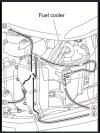The clogging fuel cooler affects mostly Yamaha outboards and the reason why Yamaha is not clear, most likely the design and/or position where not all water inside drain and then evaporate inside leaving deposits.
There is one thing to consider regarding flushing.
While Salt deposits will quickly dissolve at next use any mineral deposits will not and continue building up.
Once a certain amount of clogging happened the water flow will be so reduced that no dissolving will happen.
My boat is slipped and i don't know how hard the water there is, but in my house the water from the well is very hard and i would not flush the engine with that water for the reason above. So you may check water hardness before you flush regularly.
Second, there are zillions of outboards never getting flushed, or just once before winterizing because the can't flush where boat is and they don't clog or have particular high corrosion issues.
However, if your water if not hard then i would flush your engines and maybe end of season run the outboards in a tank with Redlyme added to descale the water passages.
A rectifier is a component that converts AC current from the engine's stator into DC current to charge the battery, and it is often referred to as a rectifier/regulator.
Some outboards have one, some not and rectifier is air cooled, if water cooled it has the same type as the fuel cooler and it can clog same way. I am not sure if your F300 has a water cooled rectifier cooler or just air cooled, ask your mechanic.
Chris


